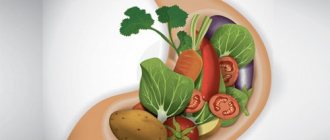Blood during constipation is a common phenomenon that can be provoked by both harmless and quite serious factors. The feces of a healthy person are characterized by normal richness and the absence of any inclusions. If there are problems with defecation, the feces become very dense, which interferes with the process of its exit through the intestines and entails bleeding
Constipation and blood from the anus: etiology of the phenomenon
The reason for this phenomenon lies in damage to the intestinal walls or anus during stress during bowel movements. The blood in such cases can have either a burgundy or scarlet hue. Blood inclusions in the stool can also stimulate infectious or pathological phenomena. In the first case, the role of “provocateurs” is:
- dysentery - accompanied by the penetration of bacteria into the intestinal cavity. The patient develops cramping abdominal pain, flatulence, and symptoms of body intoxication;
- amoebiasis. The disease is caused by amoebas. Pathogenic microorganisms penetrate the intestines, destroy its walls, stimulating the dilution of feces and the release of blood;
- belantidiasis - the disease develops as a result of the active activity of protozoan microbes - balantidia. The symptoms are similar to the clinical picture of amoebiasis, they are sluggish in nature and provoke constipation or diarrhea with blood.
Among the pathological reasons for the presence of characteristic inclusions during a complicated act of defecation:
- hemorrhoids are pathological phenomena of the venous system in the anus, which occur together with the formation of hemorrhoidal cones - they increase over time, fall out and bleed during a complicated bowel movement;
- cracks in the walls of the rectum. The lining of the intestinal walls is greatly stretched when feces accumulate - microcracks are formed, which bleed along with tension;
- intestinal polyps are benign tumors that bleed when damaged by hardened feces;
- oncology. Tumor manifestations are often manifested by bleeding. As the tumor grows, the intestines narrow - constipation worsens and develops into a chronic form.
- colitis – the formation of an inflammatory process in the colon mucosa. A prolonged illness is expressed in the form of copious mucus secretion, erosions and minor bleeding.
All the mentioned factors of bloody discharge are united by one pattern: the stimulating phenomenon in all cases is mechanical injury to the mucous membrane of the organ due to the difficult passage of feces through the intestines.
Worth reading! “Causes of inflammation of hemorrhoids.”
Characteristics of bleeding
Already by the appearance of the blood, its color, the characteristics of the content in the feces, and the time of excretion, one can presumably determine the level of intestinal damage.
- fresh scarlet blood on underwear and/or toilet paper - anal fissure, initial stage of hemorrhoids, damage to the anus due to constipation;
- fresh scarlet blood, not mixed with feces, in the form of drops, splashes, stripes, puddles - hemorrhoids, anal fissure, polyps, rectal cancer;
- dark blood mixed with feces, in the form of clots, streaks - polyps, cancer of the descending colon, sigmoid colon, diverticulitis;
- diarrhea mixed with blood, large amounts of mucus, pus - inflammatory bowel diseases, intestinal infections;
- feces in the form of “raspberry jelly” - cancer of the cecum, ascending colon, dysentery, damage to the small intestine;
- black blood in the stool, tarry stools (melena) - bleeding in the stomach or duodenum.
The less the blood is changed and the less it is mixed with feces, the lower the source of bleeding is located.
Blood in the stool during constipation: features of the clinical picture of the phenomenon
Usually, spotting due to problems with bowel movements is observed in tandem with other symptoms, including:
Recipes, menus and diet products
- pain in the abdominal cavity;
- heartburn;
- belching.
The patient may experience nausea, vomiting, and discomfort in the abdominal area after eating food. In addition to blood, accumulations of mucus are often discharged from the anus. With hemorrhoids, a person experiences pain from the anus, which is stimulated by the worsening of the disease.
Constipation, bloody stool: diagnostic specifics
Differential diagnosis in the described case involves excluding fistula, syphilis, and tuberculosis. As part of the diagnosis of pathology, the patient is prescribed a number of the following measures:
- taking an anamnesis (the distinctive features of the course of the disease are determined, the underlying disease is studied). Additionally, specialists determine the duration of clinical manifestations and factors stimulating the phenomenon;
- visual inspection of the anal area;
- list of standard laboratory tests;
- ultrasonography;
- fluoroscopy of the intestine (the neoplasm and the area of blockage are determined);
- rectoscopy (examination is aimed at assessing the condition of the lower intestines - hemorrhoids, fissures, oncology are diagnosed);
- Colonoscopy is a procedure aimed at diagnosing the large intestine.
Worth adopting! “Prevention of hemorrhoids in men and women”
Determining the cause of pathology by blood condition
In some cases, it becomes possible to assess the condition of the blood released from the anus. Attention is paid to the color, volume and nature of the discharge. The brighter the blood, the closer to the anus the inflammatory focus is located. With rectal bleeding, the blood may be:
- scarlet (usually appears with anal fissures and damage to hemorrhoids);
- dark (indicates inflammation occurring in the upper gastrointestinal tract).
The described patterns are determined by the fact that as the blood moves to the anus, it changes its color and consistency.
Attention! If a patient develops an infection, blood in the stool is usually present in the form of streaks. The bleeding is also slimy and has a rotten smell. In the latter case, we are talking about the development of stomach pathologies.
Preventive measures
To avoid the unpleasant effects of constipation, doctors advise using the following procedures:
- Enema. The procedure cannot be used often, but only in cases where there is a real threat of fecal formation.
- Increasing the daily volume of fluid you drink.
- Special diet. A food format is selected that helps soften stool and promote its removal.
- Changing a sedentary lifestyle to an active one.
- Eliminating bad habits.
- Periodic examination in medical institutions to identify diseases of the gastrointestinal tract.
Source
Constipation - bleeding: what to do and where to go?
If you notice the first symptoms of a gastrointestinal disorder, you should make an appointment with a doctor. A proctologist will help with intestinal pathologies. The reason for calling an ambulance may be:
- increasing volume of blood released;
- inability to stop bleeding for a sufficiently long period of time;
- intense multiple vomiting with blood;
- bruising, bleeding through the nasal passages;
- hyperthermia;
- acute pain syndrome in the peritoneum.
It will be useful to know! “Why does a lump appear in the anus?”
Blood after constipation: therapeutic measures
The therapeutic course under the described circumstances involves the use of two main tools: medicines and traditional medicine. The first group includes:
- irritants (increase intestinal motility) – Regulax, Senadexin;
- osmotic drugs (increasing osmotic pressure in the organs of the local area) - sodium sulfate, magnesium sulfate;
- fillers (medicines help to liquefy stool) – wheat bran, cellulose;
- prebiotics (retain fluid in the intestines, stimulate the process of removing toxins) - Duphalac.
Recipes for the most effective folk remedies are presented in the table below:
| Means | Recipe/Usage |
| Apple-beet juice | Take 2 parts apple juice (freshly squeezed) and 1 part beet juice. Drink 200 ml on an empty stomach in the morning |
| Flax seed infusion | Flaxseed in the amount of 1 tsp. pour 200 ml of boiling water. Let cool, strain with gauze. Take 50 ml before meals |
| Vegetable oil | Take 1 tbsp. l. any vegetable oil on an empty stomach, washed down with water and lemon juice |
| Treatment with pure water | Drink 2 glasses of warm water in the morning after waking up and 200 ml of clean water 20 minutes before meals |
| Senna herb infusion | The main component in the amount of 2 tbsp. l. pour 200 ml of boiling water. Insist, strain and take before going to bed |
In addition to treating constipation with medications and folk remedies, treatment is carried out for the main pathology that caused constipation and bleeding.
Might be worth a read! "Stages of hemorrhoids and their treatment methods."
When to see a doctor
Any changes in the functioning of the gastrointestinal tract, especially if they have permanent manifestations, require diagnosis, which is carried out in medical institutions. An experienced specialist (proctologist or coloproctologist) is able to determine the true cause of fecal stagnation and explain the presence of bloody bodies, purulent formations and mucus in them by taking tests.
Additional diagnostic methods in the form of ultrasound, sigmoidoscopy, biopsy, intestinal colonoscopy and radiography are used if simpler types of studies do not explain the reason for the presence of blood in the stool.
Blood due to constipation in a child
The threat of constipation with bloody discharge in childhood is the saturation of stool with components that can cause toxicosis in the body. The patient hides the problem from his parents - ignored defecation problems lead to the appearance of cracks in the anal area. Typically, in this category of patients, blood is formed in the stool due to:
- organic constipation (pathology is provoked by disorders of the gastrointestinal tract or abnormalities in the anatomical structure of the intestine - most often diagnosed in infants);
- functional constipation (the problem is stimulated by various disorders caused by inappropriate nutrition, lack of fluid, etc.).
If characteristic symptoms of the disease are detected, you should contact your pediatrician. Treatment of the disease in children is carried out taking into account the patient’s age and the specific clinical picture of the pathology.
In conclusion, it is worth touching on the topic of prevention. To prevent blood on paper after constipation from taking you by surprise one day, you should adhere to appropriate preventive measures. Prevention of pathology consists of following a diet, maintaining a healthy and active lifestyle, and increasing the daily amount of fluid you drink. In some cases, it is advisable to use an enema. This method of solving the problem can only be used if there is a real possibility of the formation of hardened feces.
It might be useful to know! “What to do if hemorrhoids come out? first aid and signs."
Treatment options
Therapy is prescribed taking into account the reasons that caused the appearance of blood in the stool. To diagnose the disease, laboratory and instrumental examination of the intestines and ultrasound of the abdominal cavity are performed. The doctor interviews the patient, examines and palpates the abdomen, and finds out what complaints bother him.
For spontaneous or constipation caused by psychogenic factors, diet therapy, therapeutic exercises, and the development of a conditioned reflex to bowel movement are prescribed. To facilitate bowel movements, laxatives and cleansing enemas are used. Pro- and prebiotics are prescribed to patients to normalize intestinal microflora. Pain is relieved with antispasmodics and non-steroidal anti-inflammatory drugs.
Medicines
Many patients turn to the doctor with the question: how to treat constipation in order to avoid the appearance of blood in the stool. Laxatives for local (suppositories, microenemas) or systemic use (drops) help to liquefy hard feces and quickly cleanse the intestines.
Laxatives for constipation:
In case of constipation with bleeding, it is forbidden to use laxatives for a long time, this can cause psychological addiction, intestinal atony, and electrolyte imbalance in the body. In acute inflammatory diseases, drugs for oral administration are not prescribed; in such cases, suppositories or pharmaceutical microenemas are used.
If blood flows profusely from the anus due to constipation, it is necessary to take a hemostatic agent (Vikasol, Dicynon) and call an ambulance, since such a symptom may indicate intestinal bleeding. To strengthen the veins of the rectum and prevent blood loss during defecation in patients with hemorrhoids, venotonics are prescribed: Troxevasin, Detralex. Pain is relieved with antispasmodics (No-shpa, Spazmalgon) or non-steroidal anti-inflammatory drugs (Mydocalm, Nimesulide).
Patients with anal fissures, when visiting a proctologist, are interested in what to do to alleviate the condition. Ointments for external use help to remove swelling, spasm, reduce inflammation, and speed up wound healing: Levomekol, Relief, sea buckthorn ointment. To prevent infection of cracks, it is recommended to take warm sitz baths with a decoction of chamomile, calendula, a solution of baking soda, and potassium permanganate.
Cleansing enemas
If blood appears in the stool after constipation, acute symptoms of inflammation of the digestive tract are bothering you, you can cleanse the intestines at home with an enema. To do this, add sea buckthorn, vaseline or linseed oil to warm water, draw the solution into a rubber syringe and carefully inject it into the anus. Fatty liquid facilitates the passage of feces and reduces the risk of injury to the mucous membranes.
This remedy is contraindicated in the presence of purulent wounds, as it can delay the discharge of necrotic masses. For paraproctitis, it is allowed to add soap with neutral pH and herbal decoctions to the water. You can also use a pharmacy microenema - Microlax.
Diet food
To prevent bleeding from the anus after constipation, it is necessary to normalize the stool. In addition to taking medications and cleansing enemas, patients are advised to change their daily diet. You should eat more foods rich in plant fiber, which stimulate intestinal motility.
Important! Before drawing up a menu, you need to determine why blood appears in the stool during constipation. For inflammatory diseases of the gastrointestinal tract, there is a list of prohibited foods that can increase symptoms of illness.
Dishes with fixing properties are removed from the menu. During treatment, you should avoid rice porridge, low-fat cottage cheese, quince, persimmon, pomegranate, green apples, bananas, raisins, grapes, jelly, pasta, chocolate, white bread and pastries. Dried fruit compote, strong tea, and red wine also strengthen the chair.
Products that have a laxative effect for constipation with blood:
- buckwheat, wheat groats;
- boiled beets, carrots, pumpkin;
- plums, pears, ripe apples, bananas, apricots;
- fresh juices;
- prunes, dried apricots;
- curdled milk, fat cottage cheese.
It is necessary to eat fractionally 5-6 times a day. The majority of the portion should be vegetables, salads, and fruits. The last meal should occur no later than 3 hours before bedtime. The drinking regime should be observed; an adult should drink at least 1.5 liters of clean still water per day.
If the stool is disturbed, dyspeptic disorders appear, blood appears in the stool due to constipation, it is necessary to consult a doctor and find out the cause of the pathology. To facilitate bowel movements, laxatives and cleansing enemas are used. In case of heavy bleeding, urgent cessation of hemorrhage with hemostatic agents is required. Diet therapy helps restore intestinal microflora and improve peristalsis.
Source











